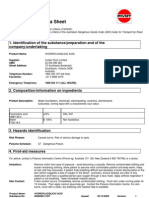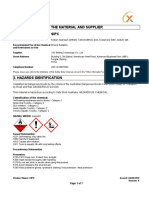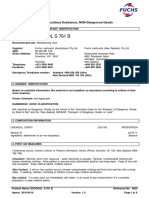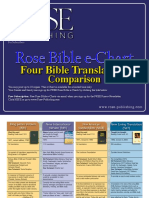MSDS Oven Cleaner Caustic Commercial Grade
MSDS Oven Cleaner Caustic Commercial Grade
Uploaded by
yakazeCopyright:
Available Formats
MSDS Oven Cleaner Caustic Commercial Grade
MSDS Oven Cleaner Caustic Commercial Grade
Uploaded by
yakazeOriginal Title
Copyright
Available Formats
Share this document
Did you find this document useful?
Is this content inappropriate?
Copyright:
Available Formats
MSDS Oven Cleaner Caustic Commercial Grade
MSDS Oven Cleaner Caustic Commercial Grade
Uploaded by
yakazeCopyright:
Available Formats
Material Safety Data Sheet
STATEMENT OF HAZARDOUS NATURE
This material is hazardous according to criteria of NOHSC. Classified as Dangerous Goods by the criteria of the Australian Dangerous Goods Code (ADG Code) for Transport by Road and Rail.
1. IDENTIFICATION OF THE MATERIAL AND SUPPLIER
Product Name: OVEN
CLEANER
Supplier: Ultimax Chemicals Street Address: 56 Antimony St CAROLE PARK, QLD 4300 Telephone Number: +61 7 3800 9731 Facsimile: +61 7 3800 9714
2. COMPOSITION / INFORMATION ON INGREDIENTS
Product Description: Use on cold oven. Sprays on affected areas. Leave till penetrate baked residue. Components / CAS Number Proportion Risk Phrases Water 7732-18-5 >60% Caustic Soda CAS# 1310-58-3 10-<30% R20/21/22 R36/37/38 2 mg/m3 TWA NOHSC Alkaline Salts <10% R11 Surfactants <10% R12
3. HAZARDS IDENTIFICATION
DANGEROUS GOODS CLASS: PACKING GROUP HAZCHEM CODE: POISON SCHEDULE NUMBER: SAFETY PHRASES 8 III 2R S6
S1/2: Keep locked up and out of reach of children. S26: In case of contact with eyes, rinse immediately with plenty of water and seek medical advice. S37/39: Wear suitable gloves and eye/face protection. S45: In case of accident or if you feel unwell, seek medical advice immediately (show label or MSDS where possible).
4. FIRST AID MEASURES
Product Name: Oven Cleaner Non Caustic For advice, contact a Poisons Information Centre Australia Ph: 131 126 or a doctor. Inhalation: Remove victim from area of exposure - avoid becoming a casualty. Remove contaminated clothing and loosen remaining clothing. Allow most comfortable position and keep warm. Keep at rest until fully recovered. Seek medical advice if effects persist. Skin Contact: If skin or hair contact occurs, immediately remove any contaminated clothing and wash skin and hair thoroughly with running water. If swelling, redness, blistering or irritation occurs seek medical assistance. Eye Contact: If in eyes, hold eyelids apart and flush the eye continuously with running water. Continue flushing until advised to stop by the Poisons Information Centre or a doctor, or for at least 15 minutes. Ingestion: Rinse mouth with water. If swallowed, do NOT induce vomiting. Give a glass of water. Seek immediate medical assistance. Notes to physician: Treat symptomatically.
Material Safety Data Sheet
5. FIRE FIGHTING MEASURES
Specific Hazards: Flammable gas. Fire-fighting advice: Heating can cause expansion or decomposition of the material, which can lead to the containers exploding. If safe to do so, remove containers from the path of fire. Keep containers cool with water spray. Fire fighters to wear self-contained breathing apparatus and suitable protective clothing if risk of exposure to vapour or products of combustion. Suitable Extinguishing Media: Water fog (or if unavailable fine water spray), foam, dry agent (carbon dioxide, drychemical powder).
6. ACCIDENTAL RELEASE MEASURES
Shut off all possible sources of ignition. In the event of an aerosol can developing a leak, allow to fully discharge in the open air before disposal.
7. HANDLING AND STORAGE
Handling advice: Avoid skin and eye contact and breathing in vapour, mists and aerosols. Ensure spray nozzle is always directed away from the user. Storage advice: Store in cool place and out of direct sunlight. Store away from sources of heat or ignition. Store away from foodstuffs. Store away from incompatible materials described in Section 10. Keep containers closed when not in use - check regularly for leaks. This material is a Scheduled Poison S6 and must be stored, maintained and used in accordance with the relevant regulations.
8. EXPOSURE CONTROLS/PERSONAL PROTECTION
Occupational Exposure Limits: No value assigned for this specific material by the National Occupational Health and Safety Commission. However, Exposure Standard(s) for constituent(s): As published by the National Occupational Health and Safety Commission. No Exposure Standards assigned to other constituents. TWA - The time-weighted average airborne concentration over an eight-hour working day, for a five-day working week over an entire working life. STEL (Short Term Exposure Limit) the average airborne concentration over a 15 minute period which should not be exceeded at any time during a normal eight hour work day. According to current knowledge this concentration should neither impair the health of, nor cause undue discomfort to, nearly all workers. Asphyxiant gases which can lead to reduction of oxygen concentration by displacement or dilution. The minimum oxygen content in air should be 18% by volume under normal atmospheric pressure. These Exposure Standards are guides to be used in the control of occupational health hazards. All atmospheric contamination should be kept to as low a level as is workable. These exposure standards should not be used as fine dividing lines between safe and dangerous concentrations of chemicals. They are not a measure of relative toxicity. Engineering Control Measures: Ensure ventilation is adequate and that air concentrations of components are controlled below quoted Exposure Standards. Use in well ventilated areas. Keep containers closed when not in use. An asphyxiant gas which can lead to the displacement or dilution of oxygen. The minimum oxygen content in air should be 18% by volume under normal atmospheric pressure. Personal Protective Equipment: MANUFACTURE, PACKAGING AND TRANSPORT: Wear clean overalls, safety boots, general purpose gloves (PVC) and safety spectacles. Always wash hands before smoking, eating, drinking or using the toilet. Wash contaminated clothing and other protective equipment before storage or re-use. If risk of inhalation exists, wear organic vapour/particulate respirator meeting the requirements of AS/NZS 1715 and AS/NZS 1716. FOR CONSUMER USE: Avoid contact with eyes and skin and breathing in mist. Wash hands after use. Rubber gloves are recommended if handling often.
Material Safety Data Sheet
9. PHYSICAL AND CHEMICAL PROPERTIES
Physical state: Liquid Odour: Natural Scent Specific Gravity: 1.15 1.21@20C Relative Vapour Density (air=1): N a Vapour Pressure (20 C): N a Flash Point (C): N /a Flammability Limits (%): N/A Autoignition Temperature (C): N a % Volatile by Volume: 93 (approx) Solubility in water (g/L): Miscible Melting Point/Range (C): N/A Boiling Point/Range (C): N/A Decomposition Point (C): N/A pH: > 12.5 Viscosity: N/A Evaporation Rate: N a
10. STABILITY AND REACTIVITY
Stability: Reacts with acids and oxidising agents . Incompatible with aluminium and zinc.
11. TOXICOLOGICAL INFORMATION
No adverse health effects expected if the product is handled in accordance with this Safety Data Sheet and the product label. Symptoms or effects that may arise if the product is mishandled and overexposure occurs are: Ingestion: Swallowing can result in nausea, vomiting, diarrhoea, and abdominal pain. Eye contact: An eye irritant. Skin contact: Contact with skin will result in irritation. Inhalation: Breathing in vapour can result in headaches, dizziness, drowsiness, and possible nausea. Intentional misuse by deliberately concentrating and breathing the contents can be harmful or fatal. Long Term Effects: No information available for the product. Toxicological Data: No LD50 data available for the product.
12. ECOTOXICOLOGICAL INFORMATION
Avoid contaminating waterways.
13. DISPOSAL CONSIDERATIONS
Refer to Waste Management Authority. Advise flammable nature. Do not puncture or burn can when empty; contents are under pressure. If aerosol can develops a leak, allow to fully discharge before disposal. Normally suitable for disposal at approved land waste site.
Material Safety Data Sheet
14. TRANSPORT INFORMATION
Road and Rail Transport Classified as Dangerous Goods by the criteria of the Australian Dangerous Goods Code (ADG Code) for Transport by Road and Rail. UN No: 1719 Class-primary Proper Shipping Name: Caustic Liquid Hazchem Code: 2R Marine Transport: Classified as Dangerous Goods by the criteria of the International Maritime Dangerous Goods Code (IMDG Code) for transport by sea. Air Transport: Classified as Dangerous Goods by the criteria of the International Air Transport Association (IATA) Dangerous Goods Regulations for transport by air.
15. REGULATORY INFORMATION
Classification: This material is hazardous according to criteria of NOHSC. Xi: Irritant Risk Phrase(s):. R41Risk of serious damage to eyes R36/38: Irritating to eyes and skin. Safety Phrase(s): S1/2: Keep locked up and out of reach of children. S24/25: Avoid contact with skin and eyes. S26: In case of contact with eyes, rinse immediately with plenty of water and seek medical advice. S28: After contact with skin, wash immediately with plenty of soap and water. S37/39: Wear suitable gloves and eye/face protection Poisons Schedule: S6. All the constituents of this material are listed on the Australian Inventory of Chemical Substances (AICS).
16. OTHER INFORMATION
Phone: 0500 576 528 (Australia wide) Fax: 0500 576 538 (Australia wide) Reason(s) for Issue: This MSDS summarises to our best knowledge at the date of issue, the chemical health and safety hazards of the material and general guidance on how to safely handle the material in the workplace. Ultimax Chemicals Australia cannot anticipate or control the conditions under which the product may be used, each user must, prior to usage, assess and control the risks arising from its use of the material. If clarification or further information is needed, Ultimax Chemicals representative. MSDS Verification Date Date of Issue: 2nd of April 2005 Date of Review: 2nd April 2010
You might also like
- Marketing CasebookDocument34 pagesMarketing CasebookGandhi MardiNo ratings yet
- Legal Aspect in NursingDocument11 pagesLegal Aspect in Nursingdpenaflor100% (7)
- Soal Yang Sering Muncul Di MTCNA MikroTikDocument4 pagesSoal Yang Sering Muncul Di MTCNA MikroTikdestu kurniadi88% (8)
- Safety Data Sheet: Section 2: Hazards IdentificationDocument5 pagesSafety Data Sheet: Section 2: Hazards IdentificationaldiNo ratings yet
- HDAX 5200 Low Ash Gas Engine Oil-MSDSDocument6 pagesHDAX 5200 Low Ash Gas Engine Oil-MSDSAlin AspiryeNo ratings yet
- Material Safety Data Sheet of OXALIC ACIDDocument5 pagesMaterial Safety Data Sheet of OXALIC ACIDtradeasiagroupNo ratings yet
- M S D S: Aterial Afety ATA HeetDocument5 pagesM S D S: Aterial Afety ATA Heetmatthewnathan89No ratings yet
- Rp7-Aus SDSDocument7 pagesRp7-Aus SDSRùa ConNo ratings yet
- Mono Ethylene Glycol MEGDocument6 pagesMono Ethylene Glycol MEGtabriz.alizada.engNo ratings yet
- Yixing Cleanwater Chemicals Co.,Ltd: Material Safety Data SheetDocument6 pagesYixing Cleanwater Chemicals Co.,Ltd: Material Safety Data SheetEpl Iwwrt BDNo ratings yet
- IXOM Caustic Soda Pearls MSDSDocument7 pagesIXOM Caustic Soda Pearls MSDSStariunNo ratings yet
- Paxcool Premix 40: Safety Data SheetDocument6 pagesPaxcool Premix 40: Safety Data SheetDavid NguyenNo ratings yet
- Fluosilicic - Acid.hydrofluosilicic PIVOTDocument5 pagesFluosilicic - Acid.hydrofluosilicic PIVOTVYSUPER6No ratings yet
- Y&X MSDS of SAXDocument7 pagesY&X MSDS of SAXmishaNo ratings yet
- MSDS Tanah ElektrolitDocument5 pagesMSDS Tanah ElektrolitBayu HidayatNo ratings yet
- TDAE (Treated Distillate Aromatic Extract) : Safety Data SheetDocument6 pagesTDAE (Treated Distillate Aromatic Extract) : Safety Data SheetBumble BeeNo ratings yet
- Aqueous AmoniaDocument7 pagesAqueous AmoniaArief Rahman DhuhriNo ratings yet
- Sipx MSDS Y&xDocument7 pagesSipx MSDS Y&xmishaNo ratings yet
- Safety Data Sheet: 1. Identification of The Material and Supplier Sodium Aluminate SolutionDocument7 pagesSafety Data Sheet: 1. Identification of The Material and Supplier Sodium Aluminate SolutionHeinrich ManaligodNo ratings yet
- Maintain Fricofin DP-SDSDocument6 pagesMaintain Fricofin DP-SDSsxturboNo ratings yet
- Sulphuric Acid 35%: Safety Data SheetDocument7 pagesSulphuric Acid 35%: Safety Data SheetHương HươngNo ratings yet
- MSDS SMF Lead Acid BatteryDocument9 pagesMSDS SMF Lead Acid Batteryebbasingh100% (1)
- Material Safety Data Sheet: Loctite 263 ThreadlockerDocument4 pagesMaterial Safety Data Sheet: Loctite 263 Threadlockerpichet33No ratings yet
- MSDS Nya Soda AshDocument5 pagesMSDS Nya Soda AshtradeasiagroupNo ratings yet
- Acetic Acid 45% W/W: Safety Data SheetDocument8 pagesAcetic Acid 45% W/W: Safety Data Sheetkashif irshadNo ratings yet
- Material Safety Data Sheet: 26095 MsdsDocument3 pagesMaterial Safety Data Sheet: 26095 Msdsa.mohamedlathifNo ratings yet
- Flusilazole Cane Strike LiquidDocument8 pagesFlusilazole Cane Strike LiquidDeti RatnaNo ratings yet
- Safety Data Sheet: 1. Identification of The Material and Supplier Ixosurf LabsDocument7 pagesSafety Data Sheet: 1. Identification of The Material and Supplier Ixosurf LabsJoseNo ratings yet
- 343 Ghs Multipurpose Acid CleanerDocument8 pages343 Ghs Multipurpose Acid Cleanersafety kbiNo ratings yet
- M S D S: Aterial Afety ATA HeetDocument5 pagesM S D S: Aterial Afety ATA HeetSJHEIK Abdullah100% (1)
- All Purpose Thinner Sep11Document4 pagesAll Purpose Thinner Sep11Paul De ChaufepieNo ratings yet
- Hypogear 80W-90 - BP Australia Pty LTDDocument5 pagesHypogear 80W-90 - BP Australia Pty LTDBiju_PottayilNo ratings yet
- Caustic Soda 99 - Aus SdsDocument8 pagesCaustic Soda 99 - Aus SdsThatoNo ratings yet
- 721 GHS Cip DetergentDocument9 pages721 GHS Cip Detergentnavoda.ranvelNo ratings yet
- Fosroc Conbextra CB: Safety Data SheetDocument8 pagesFosroc Conbextra CB: Safety Data SheetTanmay VegadNo ratings yet
- AkzoNobel SMCA MSDS 0909 Tcm18-10237Document0 pagesAkzoNobel SMCA MSDS 0909 Tcm18-10237David HoffmanNo ratings yet
- CHLORITE - Liquid Bleach - EXP Oct 2021Document7 pagesCHLORITE - Liquid Bleach - EXP Oct 2021brianNo ratings yet
- Fosroc Nitobond AR - MSDSDocument4 pagesFosroc Nitobond AR - MSDSSantos RexNo ratings yet
- Texamatic 1888: Safety Data SheetDocument7 pagesTexamatic 1888: Safety Data Sheethoussem houssemNo ratings yet
- AFTEK - Penapatch Fairing Coat Mortar SDS 2009Document4 pagesAFTEK - Penapatch Fairing Coat Mortar SDS 2009Aria NickbakhtNo ratings yet
- Hydrochloric Acid 33%: Safety Data SheetDocument8 pagesHydrochloric Acid 33%: Safety Data SheetsenguttuvanNo ratings yet
- Safety Data Sheet - Pearl Liquid Hand Soap 1Document5 pagesSafety Data Sheet - Pearl Liquid Hand Soap 1Shingi MameNo ratings yet
- Astm B557Document6 pagesAstm B557wulfgang66No ratings yet
- Caustinerf ForteDocument5 pagesCaustinerf Fortefadli_nugraha6109No ratings yet
- Industrial Cleansers Pty LTD: Material Safety Data SheetDocument7 pagesIndustrial Cleansers Pty LTD: Material Safety Data SheetBruce HeathNo ratings yet
- App FF - MSDSDocument22 pagesApp FF - MSDSsenasudhaNo ratings yet
- Alcohol Hand Sanitiser-SdsDocument8 pagesAlcohol Hand Sanitiser-SdsArdiah NopriNo ratings yet
- Actrol-R123 - Msds (1) This Material Is Hazardous According To Health Criteria of Safe Work Australia. Hazard CategoryDocument6 pagesActrol-R123 - Msds (1) This Material Is Hazardous According To Health Criteria of Safe Work Australia. Hazard CategoryMani SainiNo ratings yet
- Chemical Super Mix 1Document5 pagesChemical Super Mix 1Yadwinder SinghNo ratings yet
- Lockstop Primer Adhesive SDS-GreenstreakDocument11 pagesLockstop Primer Adhesive SDS-Greenstreakrobox514No ratings yet
- Cassida Grease Eps 2-SDSDocument6 pagesCassida Grease Eps 2-SDSGabriel VictorNo ratings yet
- 07 Megapoxy 267-PartADocument9 pages07 Megapoxy 267-PartAroy.victorNo ratings yet
- Safety Data Sheet: 1. Identification of The Material and Supplier Aluminium Sulfate SolidDocument6 pagesSafety Data Sheet: 1. Identification of The Material and Supplier Aluminium Sulfate SolidrezaNo ratings yet
- MSDS - Shell Spirax - Gear OilDocument7 pagesMSDS - Shell Spirax - Gear OilAnonymous LfeGI2hMNo ratings yet
- MSDS AlumDocument5 pagesMSDS Alumdhinda clariestaNo ratings yet
- MSDS Sodium CarbonateDocument6 pagesMSDS Sodium CarbonateEndang SupriyatnaNo ratings yet
- Methanol PDFDocument6 pagesMethanol PDFmuch8888No ratings yet
- 1250 White Sds PDFDocument4 pages1250 White Sds PDFkwerwaNo ratings yet
- Omyacarb PNG - Aus GHSDocument6 pagesOmyacarb PNG - Aus GHSGİZEM DEMİRNo ratings yet
- 1712 Alkafoam FDocument6 pages1712 Alkafoam FfatihabiyayNo ratings yet
- Homework Statistics by CountryDocument8 pagesHomework Statistics by Countrygomuzefoweg3100% (1)
- ICT TradingDocument20 pagesICT TradingsteevebrugiereNo ratings yet
- ArticleDocument14 pagesArticleBEALU GIRMAYENo ratings yet
- 5 BQ Lain2Document1 page5 BQ Lain2Taufik NurcahyanaNo ratings yet
- RA 1425 and Other Rizal LawsDocument3 pagesRA 1425 and Other Rizal LawsThomas Miguel BravoNo ratings yet
- Internship Report On Muslim Commercial Bank - MCBDocument7 pagesInternship Report On Muslim Commercial Bank - MCBSana RafiqNo ratings yet
- Key TEST 1Document7 pagesKey TEST 1Hải PhươngNo ratings yet
- Argumentative EssayDocument2 pagesArgumentative Essayapi-292470526No ratings yet
- Port Huron Moose Lodge #158Document3 pagesPort Huron Moose Lodge #158Bryce AirgoodNo ratings yet
- 108學年下學期六英翰林期末考Document4 pages108學年下學期六英翰林期末考Yachi ChouNo ratings yet
- S6 - Solar System 101Document18 pagesS6 - Solar System 101Raiza DioquinoNo ratings yet
- Secondary Amenorrhea: DR Hanaa AlaniDocument44 pagesSecondary Amenorrhea: DR Hanaa AlaniAakashNo ratings yet
- Mijael Perez - Should Phones Be Allowed in SchoolDocument3 pagesMijael Perez - Should Phones Be Allowed in SchoolMijael PerezNo ratings yet
- What Is Nextcloud?Document8 pagesWhat Is Nextcloud?Walter Angolar Da SilvaNo ratings yet
- WAVEX Abstract Book FinalDocument35 pagesWAVEX Abstract Book FinalAlessandro PinNo ratings yet
- CH 02Document13 pagesCH 02leisurelarry999No ratings yet
- I Am Roberto Clemente By:Jim GigliottiDocument2 pagesI Am Roberto Clemente By:Jim GigliottiAddyNo ratings yet
- Uhlb1042 Argumentative Essay Outline (Template)Document11 pagesUhlb1042 Argumentative Essay Outline (Template)Galaxy BloxNo ratings yet
- His Birth and Early Chilhood Rizal UnfinishedDocument17 pagesHis Birth and Early Chilhood Rizal UnfinishedAdrian FetalverNo ratings yet
- Jeff102 PDFDocument16 pagesJeff102 PDFkisss100044No ratings yet
- English - The Lake Isle of InnisfreeDocument6 pagesEnglish - The Lake Isle of InnisfreeDiana D100% (1)
- Propaganda Techniques Lesson3Document19 pagesPropaganda Techniques Lesson3Andrea M. IbañezNo ratings yet
- Download Complete Advances in Usability User Experience Wearable and Assistive Technology Proceedings of the AHFE 2020 Virtual Conferences on Usability and User Experience Human Factors and Assistive Technology Human Factors and Wearable Technologies and Virtual Envi Tareq Ahram PDF for All ChaptersDocument50 pagesDownload Complete Advances in Usability User Experience Wearable and Assistive Technology Proceedings of the AHFE 2020 Virtual Conferences on Usability and User Experience Human Factors and Assistive Technology Human Factors and Wearable Technologies and Virtual Envi Tareq Ahram PDF for All Chaptersgarimapadaca44100% (3)
- September 2010 Member E-SheetsDocument11 pagesSeptember 2010 Member E-SheetsnapachamberNo ratings yet
- Bible Translations ChartDocument3 pagesBible Translations ChartRuth67% (3)
- Farm Babies: Write TheDocument12 pagesFarm Babies: Write TheTang Chia SengNo ratings yet
- Economic Geology of Sri LankaDocument21 pagesEconomic Geology of Sri LankaCharith LiyanageNo ratings yet

























































































